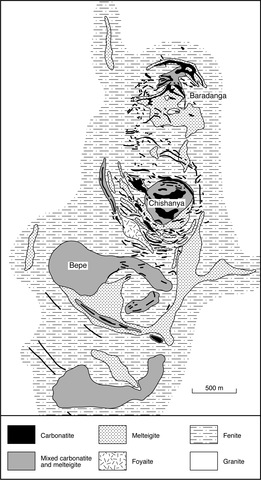stripes
The Chishanya complex consists of numerous intrusions of carbonatite and melteigite extending in a narrow belt between two parallel north-northeasterly-trending faults. The faults are marked by zones of sheared granite and quartz veins up to 200 m wide. The alkaline complex has an overall length of 5 km and width of 1.5 km with a few outliers of melteigite. In many places the carbonatites and melteigites are very intimately associated and occasionally form composite dykes. The detailed mapping of Bowen (1986) was made possible by extensive trenching during exploration for phosphate. However, although melteigite, carbonatite and a small intrusion of foyaite were mapped, three substantial intrusions are shown as consisting of melteigite plus carbonatite, the two rock types being too intimately mixed to differentiate on the scale of the map. Topographically the complex is expressed as three low hills which from north to south are Baradanga (Baran’anga), Chishanya and Bepe with much of the intervening ground being occupied by fenite. The distribution of carbonatite is irregular but there is some arcuate distribution of sheets around Chishanya Hill. The carbonatites are variable from coarse white sovites to light- to dark-brown ferruginous carbonatites and chemical analyses (Bowen, 1986) indicate both calcio- and ferrocarbonatites. The sovites contain accessory magnetite, pyrite, phlogopite, aegirine, amphibole, chlorite and vermiculite. Lenses of magnetite rock up to 10 cm across occur and possible monazite and baddeleyite have been identified. The ferruginous carbonatites commonly contain abundant magnetite and apatite and the former in places occupies as much as 70% of the rock, often as well-formed octahedra. The composition of this magnetite is available in Prins (1972). In one area bands of siderite and magnetite up to three cm thick alternate with bands of ankeritic carbonatite. Quartz and calcite form late veins and fill fractures and in places the carbonatite is almost totally replaced by quartz. The silicate rocks consist essentially of pyroxene and nepheline with the former predominating such that they are mainly melteigites rather than ijolites. They are characteristically texturally heterogeneous. The pyroxene is generally aegirine but zoned aegirine-augite also occurs. Biotite is prominent in many melteigites and grains of fayalitic olivine are present in places. Tetraferriphlogopite occurs and apatite, magnetite, pyrite and secondary calcite are accessory. Some melteigites contain up to 15% microcline, which Bowen (1986) interprets as replacement remnants of fenite. A lozenge-shaped intrusion of foyaite is situated on the southwestern side of Chishanya but its relationship with the melteigitic rocks is not apparent; it is cut by carbonatite dykes. The rock consists of aligned perthite laths, nepheline and strongly zoned aegirine-augite and accessories including sodic amphibole, biotite, pyrite and calcite. The fenite aureole is approximately 500 m wide and alkali pyroxene and amphibole are developed with phlogopite in areas close to carbonatite. Small dykes are abundant within the complex and up to 5 km distant. They are nephelinites, olivine nephelinites and phonolites with phenocryst phases including nepheline, aegirine-augite, titanaugite, hornblende, biotite, magnesian olivine and sodic plagioclase. Eleven analyses of carbonatite are in Bowen (1986) and further analyses in Swift (1952).
BOWEN, D.J. 1986. Exploration of the Chishanya carbonatite complex, Zimbabwe. In C.R. Anhaeusser and S. Maske (eds), Mineral deposits of southern Africa, 2: 2229-37. Geological Society of South Africa, Johannesburg.LEE, C.A. 1974. The geology of the Katete carbonatite, Rhodesia. Geological Magazine, 111: 133-42.PRINS, P. 1972. Composition of magnetite from carbonatites. Lithos, 5: 227-40.SWIFT, W.H. 1952. The geology of Chishanya, Buhera District, Southern Rhodesia. Transactions of the Edinburgh Geological Society, 15: 346-59.

